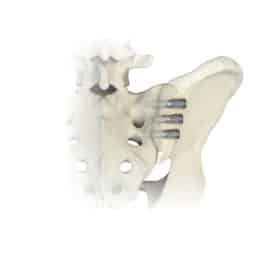For Patients
You might be on the verge of improving your quality of life.
What is the Sacroiliac (SI) Joint?
Every human has two sacroiliac (SI) joints – one on each side of their sacrum (the base of the spine). Each SI joint is load-bearing and connects the sacrum to the ilium (hip bones). The SI joint allows many movements including sitting down and standing up. These joints provide support and stability, and play a major role in absorbing impact when walking and lifting. Like any other joint in the body, one or both SI joints, can be injured or can degenerate and cause pain. The SI joint is the pain generator in about 30 percent of low back pain cases1.

Learn more about SI joint anatomy
Where does it hurt?
Tell your doctor if you have experienced any of these symptoms:

What are the possible causes?

What is the process for diagnosis?

ABOUT DIAGNOSIS
There is no single test that can diagnose sacroiliac joint dysfunction. For this reason, it is important that your doctor use a combination of diagnostic test results to form an accurate diagnosis.
A physical examination and imaging may be performed to diagnose and assess if your SI joint is the source or a contributor to your symptoms. Your doctor may recommend an SI joint injection for further confirmation.
Your doctor also will consider your health history before recommending either non-surgical or surgical treatment options.
The Diagnostic Steps*
* Diagnostic steps are patient-based and physician-dependent
Step 1
Imaging
Step 2
Physical Exam
Step 3
Positive Diagnostic Injection
DIAGNOSIS
SI Joint is the pain generator
The Physical Exam
Our SI Solutions

SIros® Lateral

SIrten® Intra-Articular

SIros O™ Oblique
* Your trained physician will identify the best Solution for you.
Patient Testimonials
Patient FAQ
Do you have questions about SI joint pain?
‛What are some of the more conservative care options?’
‛Will my insurance cover me if I need surgery?’
‛How long will it take for me to recover?’
1. Joukar A, Kiapour A, Elgafy H, Erbulut DU, Agarwal AK, Goel VK. Biomechanics of the Sacroiliac Joint: Surgical Treatments. Int J Spine Surg. 2020;14(3):355-367. Published 2020 Jun 30. doi:10.14444/7047
LEARN MORE
What causes pain in the sacroiliac joint, what are the symptoms, and what are the options for relief? Watch the video to learn more.






